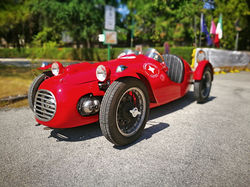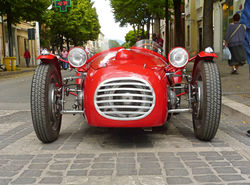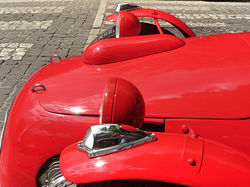
1949 Taraschi Urania 750 Sport
.jpg)
All photography work is copyrighted by the author, please don't download and publish these pictures in the internet without my permission!
Larger high quality pictures is available only for donators up on request! Vasileios Papaidis 2018 © All Rights Reserved
Meccanica Taraschi is an Italian automobile manufacturer, founder of the brands Urania, Giaur and Taraschi, active from 1947 to 1961.
Established in Teramo from Berardo Taraschi, at the end of the Second World War, the Meccanica Taraschi start building small competition cars.
The mechanical workshop of Taraschi become a real car company specialized in the production of racing cars, which will be operational until 1960 ( Mechanics Taraschi ). In 1947 he built the first two-seater sports 750, a model that was baptized with the name of Urania (the name was suggested by the Marquis de Diego Sterlich Aliprandi and is inspired by the Urania hill is located near Teramo). The model was a great success, and soon became the car to beat in the races.
Taraschi build it starting from the basic mechanics of the Fiat 500 Topolino, recovering chassis, suspension, transmission, steering and brakes, while the engine opts for BMW R75, cheap and easy to find, that he personally processes to strengthen it. The frame is also of Topolino, which is elongated in the rear area and reinforced in the central part; the body processing is performed by a specialist, the Milanese Venancio Pozzi, which Tarascans alongside a local craftsman, Giovanni Foschini, who will be able to prepare for the successive Urania.
The model debuted in Piacenza on 11 April 1947, in the Circuit de Piacenza, where Taraschi took third place, achieving the fastest lap.
While in front of the excellent results achieved by the Urania from the earliest appearances, the model suffered showy limits imposed by the original Topolino chassis, these limitations made it necessary to resort to a specific tubular chassis structure, the implementation of which Tarascans worked from the end of 1948 to complete the following spring.
After the first stage of automotive development of the post-war period, which was affected in the country clear of all issues related to the emergencies of the immediate post-war period, subsequent evolutions imposed by competition were such as to lead to the birth of Urania of the second generation, which are also modified to adapt to the new regulations of the Sports category, in particular the class 750. the new model is set to a lightweight tubular frame in drawn chromed steel, whose implementation is entrusted to Francesco Cappelli.
A revised suspension and motopropulsivo group is moved forward, resulting in criticality relative to the center of gravity, which, however, is overcome thanks to the suitable position that is given to the pilot. These are innovations that bring Urania to achieve the successes of 1949, which have a significant effect even in commercial terms, since at Tarascans are commissioned several models. The Teramo pilot proves to have reached constructive maturity and credibility, to the point that large producers of the components offer their supplies. For its sports advertising also reaches agreements that allow you to sort the most of its cars (for the tires Pirelli, Shell for fuel).
Faced with the success achieved by the Urania, Tarascans decided to try their hand at Formula 2 using a 500 displacement engine with supercharger (alternative solution to the naturally aspirated engine 2000).
Overfeeding had attracted Taraschi Paris since the Benelli, in 1939 , assisting in the Pesaro factory to work on motorcycle engines. thanks to which it can recover the Roots compressor for Taraschi compressor can count on the friendship of the Giannini brothers. The new technical solutions have major repercussions on the car, which then impose a number of subsequent interventions in the races to ensure the optimal performance of the supercharged model, which is brought to light in May 1948 in Bari Grand Prix, winning the 500 class and coming eighth in the overall standings. The adventure in Formula 2, also meant to be exploited commercially, however, is quickly abandoned in front of the penalizing comparison with naturally aspirated engines.
The 1949 is the year in which the Urania 750 gets the best results, winning several first places: in the 9th Tour of Sicily (March 20), in the Circuit Reggio Emilia (May 7), in the 1st Circuit of the Castle Teramo (May 22), in the 2nd Grand Prix of Naples (June 19), in the 3rd Cup of the Dolomites (July 17), the circuit Pescara (12 August) and in the time trial of Caltanissetta (September).
Faced with the successes and flattering Taraschi awards expresses initiative and creativity of the structural design, pushing towards the rear engine solution, with the aim of improving the weight distribution in the car, and conceiving, even with limited means, a vehicle for formula 3. This time the results are revealed immediately bad, because from the very first testing out the car, driven by the Tarascans, undergoes a double rollover. The adventure of "pattern behind everything" ends here. The disappointments for the manufacturer Teramo are also of a commercial nature since the sale of its Urania-BMW, cars difficult to drive, requiring an advanced technique that private clients have not suffered a sharp contraction.
This car original signed by the famous Maria Teresa de Filippis driver of the car at competition years.


Berardo Taraschi & Maria Teresa de Filippis on board of Taraschi Urania at Stella Alpina 1949.
Special thanks to my friend Giustina Veneruso (IT) for the concession of the car at 1st Circuito Di Avezzano 2013 "Targa Presider"
Photo Gallery
 |  |  |
|---|---|---|
 |  |  |
 |  |  |
 |  |  |
 |  |  |
 |  |  |
 |  |  |
 |  |  |
 |  |  |
 |  |  |
 |  |  |
 |  |


